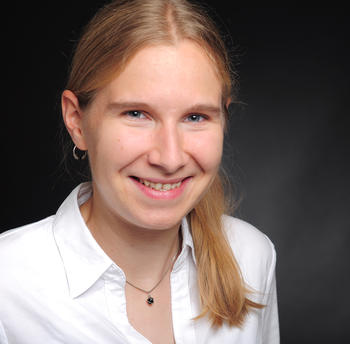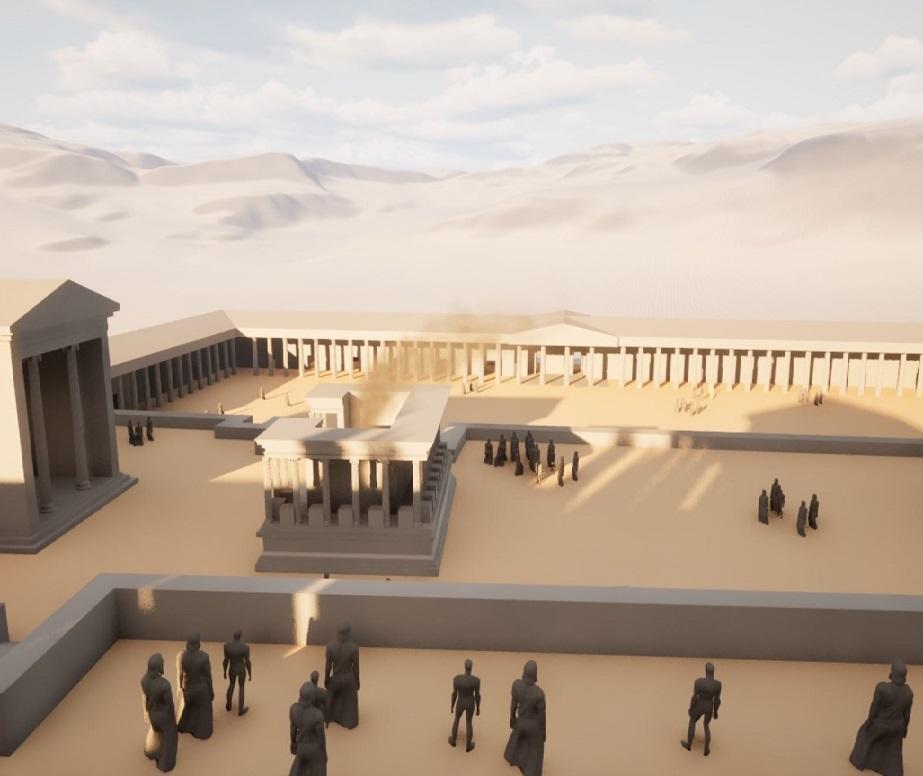Dr. Asja Müller
Mid-level Faculty Representative at the Faculty Council / Field Director (Pompeii)
General responsibilities: IT management, coordination of student assistants

Institut für Klassische Archäologie
Researcher
Room 0.0015
14195 Berlin
Office hours
since 2018/10/01
University Researcher at the Institute of Classical Archaeology, Freie Universität Berlin
2017–2018
Travel Scholarship Award of the German Archaeological Institute
2016–2017
University Researcher at the Department of Classics, Institute of Classical Archaeology, University of Kiel, CRC 1266 »Scales of Transformation«, project E3 (»Transformations in the Interrelation between Humans and Landscape between the 7th and 1st Centuries BCE in the Eastern Mediterranean«)
2017
PhD summa cum laude at the University of Kiel; thesis: »Ägyptens schöne Gesichter. Die Mumienmasken der römischen Kaiserzeit und ihre Funktion im Totenritual« [Egypt’s Beautiful Faces: The Mummy Masks of the Roman Imperial Period and Their Function in Funerary Ritual]
2013–2016
PhD Scholarship of the German National Academic Foundation
2006–2012
Studies in Classical Archaeology, Egyptology, Prehistory und Experimental Archaeology at the Universities of Leipzig and Exeter (UK)
Dynamic Spaces: Action and Perception in Hellenistic-Roman Sanctuaries (habilitation / second book)
The project looks at built space in terms of the interaction of physical (bodies) and social constituents (movement and perception). Specifically, the aim is to relate the preserved architectural inventory (using the example of Hellenistic to Imperial period Asklepieia) to the habitus of certain types of actors (theoroi [festival delegates]/local inhabitants) and specific patterns of action (festival/healing ritual), which can be reconstructed on the basis of ancient written sources. In this way, it can be investigated how the spatial experience of certain actors was shaped in the performance of certain practices and to what extent this differentiation of specific spatial constellations can be seen as a distinguishing feature of Hellenism. This explicit focus on the ancient perspective is intended to go beyond the previously prevailing holistic approach, which has analysed Hellenistic built space primarily from an arbitrary bird's-eye view or from the perspective of static, indefinite observers.

Asklepieion of Kos, Reconstruction.
Picture: Asja Müller
DFG-Project: Dynamic Spaces
The Sanctuary of Asklepios at Kos during Feast and Healing Ritual
The DFG research project aims to analyse Hellenistic architecture (using the Asklepieion of Kos as an example) at a specific point in time (mid-2nd century BC) with regard to its interaction with the actions and perceptions of human actors (external festival observers [theoroi]; local healing seekers) in two specific ancient experiential situations (festival and healing ritual).The planned study focuses on the Hellenistic period since, according to the findings of historical research, this represents a key moment in the development of a new awareness with regard to the regulation of actor response.
A digital model of the sacred complex, to be created from scratch, will serve as a heuristic instrument that (among others) includes the bodies of these actors as avatars and is capable of simulating their specific patterns of movement and perception (serious gaming approach).
At the end of the project, the result should not only be an understanding of what kind of spatial constellations have been designed with regard to certain types of actors and actions; it is also decidedly a matter of developing explanatory models for these processual spatial perception options that were tied to the respective type of actor and his or her actions (e.g. targeted movement and gaze guidance of the foreign festival observers as a means of controlling the aesthetic [external] effect of the festival). Thus, in addition to and in differentiation from previous overarching conclusions on Hellenistic architecture, the diversity of ancient built space is to be considered.

Asklepieion of Kos, Reconstruction
Picture: Amelie Nieberle, Ecaterina Cosceeva
Monographies
2021 Ägyptens schöne Gesichter. Die Mumienmasken der römischen Kaiserzeit und ihre Funktion im Totenritual, Archäologische Forschungen 39 (Wiesbaden 2021) [PhD thesis]
Editorial board
2020 A. Haug – A. Müller (Hrsg.), Hellenistic Architecture and Human Action: A Case of Reciprocal Influence, Kiel 30.10 – 02.11.2018, CRC Series [conference results, peer-reviewed]
Papers
2024 M. Giglio – A. Müller – M. Robinson – M. Trümper, Public Saunas in the Stabian Baths – A Privilege of Men, E-Journal. Scavi di Pompei 6, 2024, 2–17 [journal paper]
2024 Terracotta Fragment of a Child God from Area 200 (Suq el-Khamis), in: A. Ashmawy – D. Raue (Hrsg.), Heliopolis Reports 1 (Heidelberg 2024) 542–549 [anthology contribution, peer-reviewed]
2024 Von der (Un-)Freiheit der Handlung. Das Asklepieion von Messene, Zeitschrift für archäologische Aufklärung 1, 2024, 67-77 [journal paper, peer-reviewed]
2023 Welches Gesicht darf es sein? Entzifferungsbemühungen und Werkstattfragen bei kaiserzeitlichen Mumienmasken im Akademischen Kunstmuseum Bonn, KuBA 13, 2023, 213–244 [journal paper]
2023 A. Derbala – A. Müller, Cartonnage to Plaster: Mummy Masks of the Ptolemaic and Early Roman Periods from Tuna el-Gebel, Archäologischer Anzeiger 2022, 2023, 238–266 [journal paper, peer-reviewed]
2023 Das Leben der Mumienmasken. Zwischen Serienproduktion und Körperwerdung, MAAT. Nachrichten aus dem Staatlichen Museum Ägyptischer Kunst München 26, 2023, 14–24 [journal paper]
2020 A. Haug – A. Müller, Introduction. Hellenistic Architecture, Landscape, and Human Action, in: A. Haug – A. Müller (Hrsg.), Hellenistic Architecture and Human Action. A Case of Reciprocal Influence, Scales of Transformation in Prehistoric and Archaic Societies 10 (Leiden 2020) 11–20 [conference contribution]
2020 Secluded or Entangled. Two Modes of Architecture-Landscape Design in Hellenistic Sanctuaries, in: A. Haug – A. Müller (Hrsg.), Hellenistic Architecture and Human Action. A Case of Reciprocal Influence, Scales of Transformation in Prehistoric and Archaic Societies 10 (Leiden 2020) 125–143 [conference contribution, peer-reviewed]
2020 Hellenistic Built Space and Human Action: The Asclepieion of Cos, in: A. Haug – S. Merten (Hrsg.), Urban Practices. Repopulating the Ancient City, Studies in Classical Archaeology 8 (Turnhout 2020) 149–165 [conference contribution, peer-reviewed)
2018 Masking the Dead in Roman Egypt, in: A. Berlejung – J. E. Filitz (Hrsg.), The Physicality of the Other. Masks from the Ancient Near East and the Eastern Mediterranean (Tübingen 2018) 91–112 [conference contribution]
2017 Provenancing Roman Period Mummy Masks. Workshop Groups and Distribution Areas, in: M. Tomorad – J. Popielska-Grzybowska (Hrsg.), Egypt 2015. Perspectives of Research. Proceedings of the Seventh European Conference of Egyptologists, 2nd – 7th June 2015, Zagreb, Croatia (Oxford 2017) 127–145 [conference contribution]
2017 New Research on Roman Period Mummy Masks. The Case Example of the Budapest Museum of Fine Arts Collection, in: K. A. Kóthay (Hrsg.), Burial and Mortuary Practices in Late Period and Graeco-Roman Egypt. Proceedings of the International Conference held at Museum of Fine Arts, Budapest, 17-19 July 2014 (Budapest 2017) 293–306 [conference contribution]
2014 Sei gegrüßt, Herr des Schauens! Römische Mumienmasken in Leipzig, aMun 48, 2014, 57–60 [journal paper]
Reviews
2025 Rev. of P. Kobusch, Der Innenraum hellenistischer Tempel. Ein Ort rituellen und sozialen Handelns (Wiesbaden 2022), Gnomon 97, 2025, 208–210 [review]
Catalogue contributions
2018 Masque funéraire de femme, in: F. Chausson - G. Galliano (Hrsg.), Claude. Un empereur au destin singulier. Ausstellungskatalog Lyon (Lyon 2018) 257